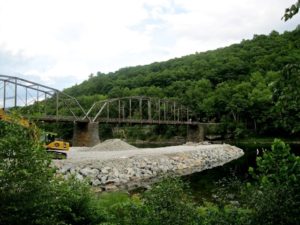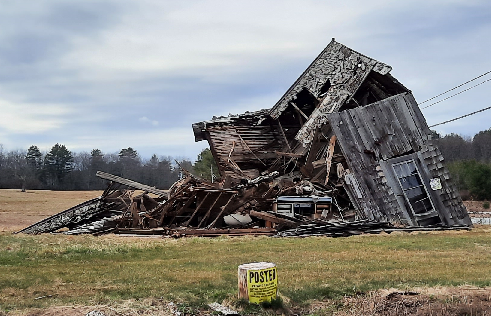Potential Impacts of Fracking on Drinking Water Resources (EPA Study)
August 11, 2016NYC Bans Use and Disposal of Fracking Waste Water
August 18, 2016By Fritz Mayer, The River Reporter, August 4, 2016
The history of the proposal to replace the Pond Eddy Bridge is fraught with groups attempting to halt the project. The new bridge will come at an estimated cost of $17 million, and serve some 23 houses located in a secluded part of Pike County, which is located across the Upper Delaware River from Pond Eddy. Critics have long said the new bridge is not needed, is too expensive and the construction will play havoc with the environment.

Now, as construction workers have piled huge quantities of rock into the river to build a causeway halfway across the river to facilitate construction, Damascus Citizens for Sustainability (DCS) and its attorney Jeff Zimmerman are looking into the permitting process that allowed the bridge to go forward.
The project involves multiple agencies and permits. One permit was granted by the U.S. Army Corps of Engineers (USACE) with the concurrence of the Federal Highway Authority (FHA) to PennDot. Zimmerman said that permit, which was issued in February, came with no public input or public notice, because the bridge was listed under one of 34 “categorical exclusions.” The project requires no Environmental Impact Statement (EIS) and therefore no public notice.
He said one USACE criteria for whether a project should have an EIS with public notice is whether the project is controversial, and the Pond Eddy Bridge has been a poster child for controversy.
There is also concern that when the causeway is moved from one side of the river, the entire river may be blocked for a brief period of time. Officials involved with the project insist this is not the case. John A. Rautzahn of SAI Consulting Engineers, Inc., wrote, “The approved design requires a minimum open channel width of 165 feet to be maintained at all times during construction. This width is the combined opening between the NY and PA channels on either side of the existing pier. This will be accomplished by moving rock from the initial causeway under the NY span to the channel under the PA span following erection of the NY truss.”
Barbara Arrindell, director of DCS, noted that the public has not seen this plan, and that questions remain such as: “how will this be done, what about equipment that is left on the island, what about refueling the equipment, and what happens if there is flooding during the construction as has happened in the past?”
Also of concern is the question of whether the bridge, which is listed on the National Register of Historic Places, is being treated as the law requires. Zimmerman said, “That seems to have been pushed aside by the state historic preservation offices for both New York and Pennsylvania, and maybe by the federal agency, the Advisory Council on Historic Preservation, that implements the National Historic Register Act.” An attempt to get a comment from the New York State Office of Historic Preservation was not immediately successful.
Another area where the laws might have not been followed concerns colonies of mussels in the river that are threatened or eligible to be listed as threatened, which Zimmerman said, “Would give them some protection under federal rules.” As he understands it, there is an agreement between the U.S. Fish and Wildlife Service, the U.S. Geological Survey and the National Park Service to relocate the mussel colony to another part of the river.
He added that the investigation by his office has discovered another colony of mussels on the New York side of the bridge that has not been moved and would be directly impacted by the construction.



